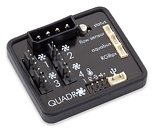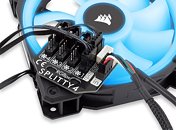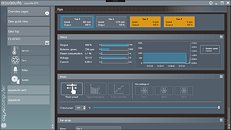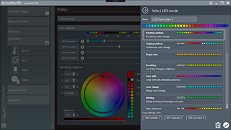Friday, June 29th 2018

Aqua Computer Announces the QUADRO: Smart LED, Fan Controller
The QUADRO made by Aqua Computer is a four channel PWM fan controller with outstanding functionality, equally suited for water cooled or air cooled computers. In addition, QUADRO has an RGBpx output for individual control of up to 64 addressable LEDs.
Fan controller
The four fan channels of the QUADRO can be configured independently, the high maximum power output of 25 watts per channel allows for connecting multiple fans to each output of the QUADRO using suitable splitters.In addition to setting fan speed manually, fan speed can also be controlled by temperature. In temperature controlled mode, set point controllers as well as curve controllers are available. If the corresponding temperature falls below the set limit, connected fans can either be switched off or be kept running at an adjustable minimum speed. For secure fan start-up, an intelligent start boost with speed signal monitoring can be configured for each fan channel.
All fan outputs are compatible to PWM fans with four pin connectors only and feature overload protection.RGBpx controller for addressable LEDs
The QUADRO controller is equipped with an RGBpx output for controlling up to 64 addressable LEDs independently. Color and brightness can be individually controlled for each LED. In total, up to four groups of LEDs of varying size can be configured, and visual effects can be assigned to each group.
The 23 available effects can be extensively adjusted for further customization. Many effects can also be configured to modify effect parameters (for example speed) depending on current sensor data. The available effects also include sound-to-light effects, visualizing computer sound output.
The AMBIENTpx effect deserves special notice, replicating the border area of the current monitor display on connected LEDs, allowing for an impressive background lighting surrounding the monitor.
Alternatively to the LED strips offered by Aqua Computer, LED fans made by Corsair and NZXT can be connected using the optional accessory RGBpx Splitty4.QUADRO can be used as an aquabus expansion device
Besides being a fully autonomous USB fan controller, the QUADRO can also be used as an aquabus extension to an aquaero 5 or aquaero 6 fan controller. In this configuration, the four fan channels of the QUADRO can be controlled by the aquaero, temperature sensor inputs and flow sensor input are transmitted to the aquaero. A maximum of two QUADRO controllers can be connected to an aquaero simultaneously.
Key features of the QUADRO include:
QUADRO and the optional RGBpx Splitty4 board will be available shortly and can be ordered in the Aqua Computer Webshop. QUADRO costs 39.90 Euro and RGBpx Splitty4 is offered for 8.90 Euro (prices include VAT).
Fan controller
The four fan channels of the QUADRO can be configured independently, the high maximum power output of 25 watts per channel allows for connecting multiple fans to each output of the QUADRO using suitable splitters.In addition to setting fan speed manually, fan speed can also be controlled by temperature. In temperature controlled mode, set point controllers as well as curve controllers are available. If the corresponding temperature falls below the set limit, connected fans can either be switched off or be kept running at an adjustable minimum speed. For secure fan start-up, an intelligent start boost with speed signal monitoring can be configured for each fan channel.
All fan outputs are compatible to PWM fans with four pin connectors only and feature overload protection.RGBpx controller for addressable LEDs
The QUADRO controller is equipped with an RGBpx output for controlling up to 64 addressable LEDs independently. Color and brightness can be individually controlled for each LED. In total, up to four groups of LEDs of varying size can be configured, and visual effects can be assigned to each group.
The 23 available effects can be extensively adjusted for further customization. Many effects can also be configured to modify effect parameters (for example speed) depending on current sensor data. The available effects also include sound-to-light effects, visualizing computer sound output.
The AMBIENTpx effect deserves special notice, replicating the border area of the current monitor display on connected LEDs, allowing for an impressive background lighting surrounding the monitor.
Alternatively to the LED strips offered by Aqua Computer, LED fans made by Corsair and NZXT can be connected using the optional accessory RGBpx Splitty4.QUADRO can be used as an aquabus expansion device
Besides being a fully autonomous USB fan controller, the QUADRO can also be used as an aquabus extension to an aquaero 5 or aquaero 6 fan controller. In this configuration, the four fan channels of the QUADRO can be controlled by the aquaero, temperature sensor inputs and flow sensor input are transmitted to the aquaero. A maximum of two QUADRO controllers can be connected to an aquaero simultaneously.
Key features of the QUADRO include:
- Programmable four channel fan controller
- All fan outputs supply up to 25 Watt of power per channel and include speed monitoring
- All fan outputs with 4-Pin connector and PWM controlled
- All fan outputs can be switched off completely
- Versatile control options
- Four temperature sensor inputs
- Eight further values can be transferred from the PC to the QUADRO using the aquasuite software
- Flow sensor input
- RGBpx LED output for LED strips and fans with individually controllable LEDs
- USB 2.0 interface
- aquasuite software for a comfortable setup, evaluation and visualization of all sensor data
- aquabus interface: QUADRO can be used as expansion for the aquaero fan controller
QUADRO and the optional RGBpx Splitty4 board will be available shortly and can be ordered in the Aqua Computer Webshop. QUADRO costs 39.90 Euro and RGBpx Splitty4 is offered for 8.90 Euro (prices include VAT).





6 Comments on Aqua Computer Announces the QUADRO: Smart LED, Fan Controller